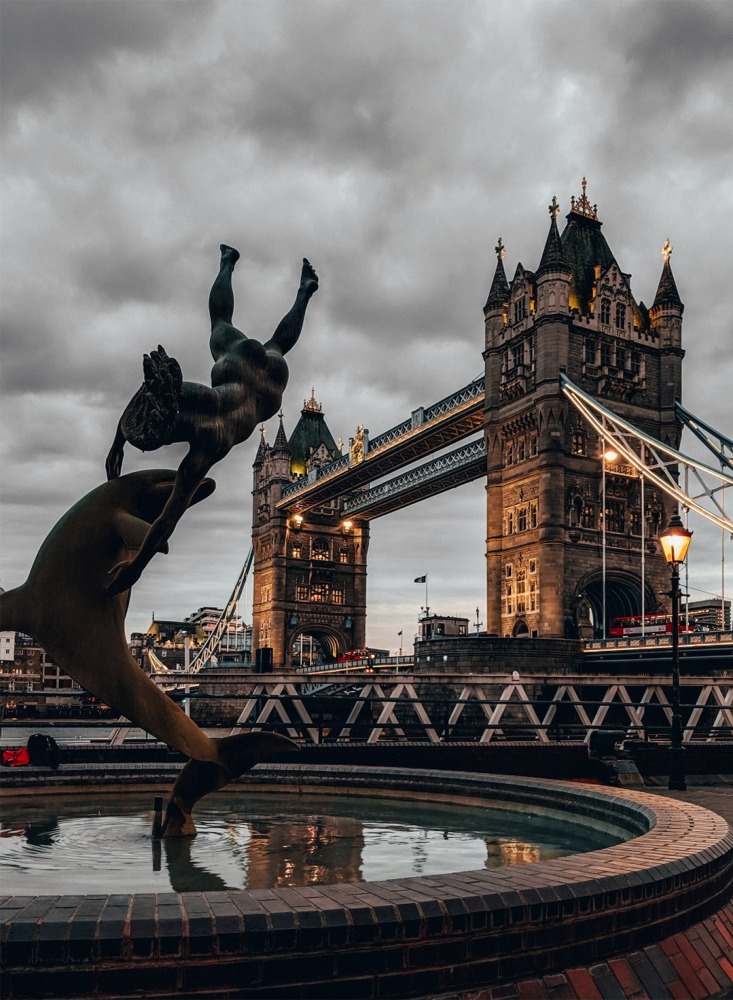Girl with a Dolphin Fountain
Home > Photos from England > London Gallery 1 > Girl with a Dolphin Fountain & Tower Bridge

The Girl with a Dolphin Fountain is a sculpture created by David Wynne. It is located in a small park at one end of Tower Bridge, near St Katherine's Dock. The sculpture depicts a young girl cavorting with a leaping dolphin.
The Girl with a Dolphin Fountain was created in 1973 and quickly became a popular landmark and tourist attraction. The sculpture is made of bronze and captures a sense of joy and playfulness. The girl's outstretched arms and the dolphin's dynamic movement convey a sense of energy and movement.
The sculpture is often interpreted as a symbol of innocence, freedom, and the connection between humans and nature. It has been widely admired for its graceful design and the way it captures the spirit of the surrounding river and cityscape.
Over the years, the Girl with a Dolphin Fountain has become an iconic piece of public art in London, attracting visitors and locals alike. It serves as a reminder of the power of art to inspire and evoke emotions.
David Wynne (sculptor)
David Wynne OBE (25 May 1926 – 4 September 2014) was a British sculptor of figures, animals, and portraits.
Biography
Born in Lyndhurst, Hampshire, son of Commander Charles Edward Wynne and Millicent (née Beyts), Wynne was educated at Stowe School and then served in the Royal Navy during World War II and read Zoology at Trinity College, Cambridge, taking up sculpture professionally in 1950. He married Gillian Grant, daughter of the writer Joan Grant, in 1959 and had two sons, Edward and Roland, who formed the psychedelic rock band Ozric Tentacles.
He did a bronze sculpture of The Beatles in 1964 and subsequently introduced them to the Maharishi Mahesh Yogi (of whom he also did a sculpture).
He was awarded the OBE in 1994.
Tower Bridge
Tower Bridge is a Grade I listed combined bascule and suspension bridge in London, built between 1886 and 1894, designed by Horace Jones and engineered by John Wolfe Barry with the help of Henry Marc Brunel. It crosses the River Thames close to the Tower of London and is one of five London bridges owned and maintained by the Bridge House Estates, a charitable trust founded in 1282. The bridge was constructed to give better access to the East End of London, which had expanded its commercial potential in the 19th century. The bridge was opened by Edward, Prince of Wales and Alexandra, Princess of Wales in 1894.
The bridge is 800 feet (240 m) in length and consists of two 213-foot (65 m) bridge towers connected at the upper level by two horizontal walkways, and a central pair of bascules that can open to allow shipping. Originally hydraulically powered, the operating mechanism was converted to an electro-hydraulic system in 1972. The bridge is part of the A100 London Inner Ring Road and thus the boundary of the London congestion charge zone, and remains an important traffic route with 40,000 crossings every day. The bridge deck is freely accessible to both vehicles and pedestrians, whereas the bridge's twin towers, high-level walkways and Victorian engine rooms form part of the Tower Bridge Exhibition.
Tower Bridge has become a recognisable London landmark. It is sometimes confused with London Bridge, about 0.5 miles (800 m) upstream, which has led to a persistent urban legend about an American purchasing the wrong bridge.
From Wikipedia, the free encyclopedia.


